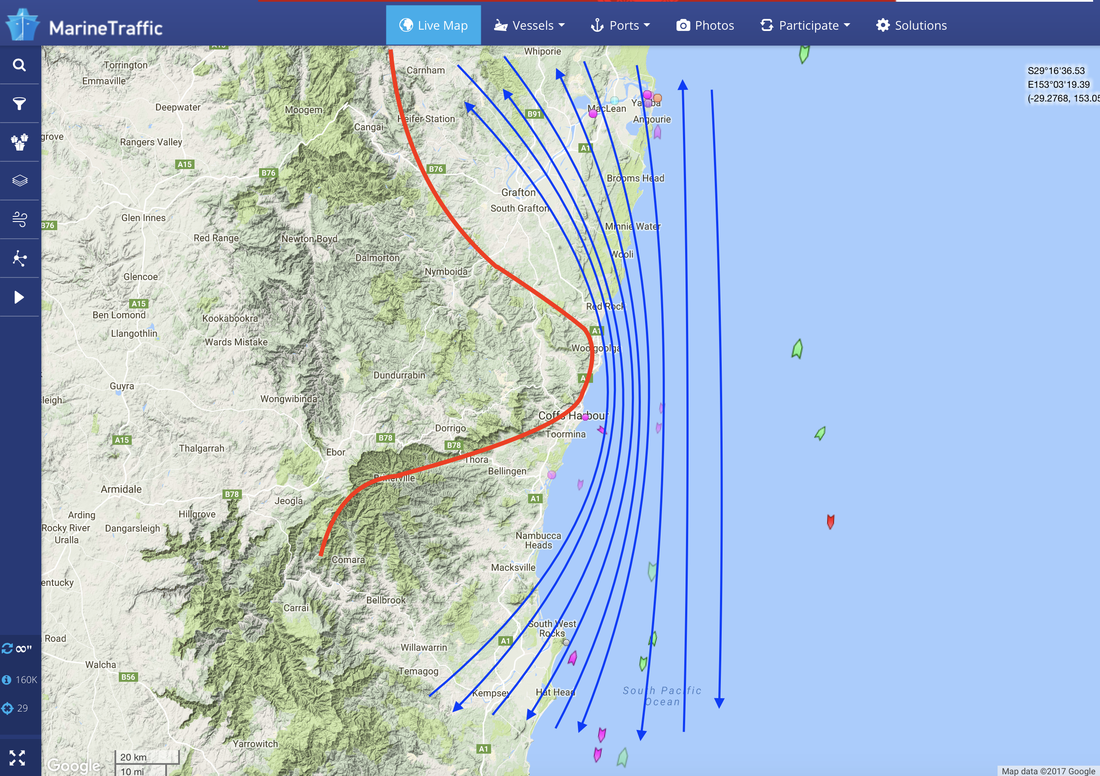|
The Coastal Venturi Effect ...or why the wind tends to blow like hell off the Coffs Coast of Australia. Most readers will have heard of venturis. A venturi is formed when the diameter of a pipe or tube is narrowed in the middle and air (or any fluid for that matter, but in this case we're going to talk about air) is forced through. As the air is forced through the narrowing tube or duct, the speed of the air mass increases, and the pressure decreases. Older aircraft used to use venturi tubes positioned in the airflow outside the cockpit to create suction and drive gyros and so forth. And sailing skiffs used to use venturi tubes on the lower side of the hull to suck out water from the bilges while the boat was moving through the water. The venturi effect works almost as well with a half venturi, where the air is forced over a curved convex surface shape. This is something that most air travellers are affected by, because upscaling the whole venturi effect and slicing the venturi in two lengthwise, we have an aircraft wing, which acts like half a venturi - air that is flowing over the wing is forced by the wing profile to accelerate as it is forced to flow in a curved path over the upper surface of the wing, this being driven by the physics of the venturi effect to flow faster as it does, while at the same time, the pressure drops. This lowering of pressure over the top of an aircraft wing moving through the air is effectively "sucking" up the top of the wing, or more correctly, producing "lift" to keep the aircraft in the air. Many people assume that pressure under the wing of an aircraft is what keeps an aeroplane flying, but in fact, it is the half-venturi effect on the top of the wing that produces the lift that keeps the aircraft in the air. Upscaling the venturi effect to geography, and looking closely at the map of the Coffs Coast of NSW shown above, you can see that where the mountains and ridges of the Great Diving Range protrude eastwards towards Coffs Harbour, they are actually forming a crude macro scale half venturi. As depicted on that map, you can also see that when the wind is blowing from either the north or south, the surface component of the wind is being forced into a smaller physical space along the coast by the half venturi formed by the ranges, thus compressing the air and forcing it to flow as if through a half venturi, increasing the speed of the local wind (and coincidentally reducing the local air pressure). So when all other factors are balanced and we have no other localised atmospheric effects, most breezes blowing from the north or the south along the northern NSW coast can be expected to increase in speed eastwards from the beach far enough out to sea to where the venturi effect of the shape of the mountain range is no longer influencing the flow. In other words, a northerly breeze forecast to blow at a steady 12 knots past say Evans Head to our north and Port Macquarie to our south will blow past Coffs Harbour at some speed above that (say 18 knots for argument's sake...). How many times have you heard from boats fishing off Coffs that despite the local forecast predicting winds of say X knots from the north or south, they are struggling in a wind that's blowing at X+50% or whatever...? All too often have we received reports like that... and then we often get follow-up reports noting that the further out away from the coast the boat travelled, the wind then backed off closer to the forecast. All this is largely driven by the geography related Coastal Venturi Effect... And of course you then ask why those super computers down at the Bureau of Meteorology haven't noticed this and refined their modelling of wind forecasts for the Coffs Coast accordingly...? Beats the hell out of me, but at a guess, it's probably because the computer modelling only deals with larger scale influences on the wind over a wider area than just the Coffs Coast, and can't adjust for localised effects on the smaller scale that we see in play here. |
|

